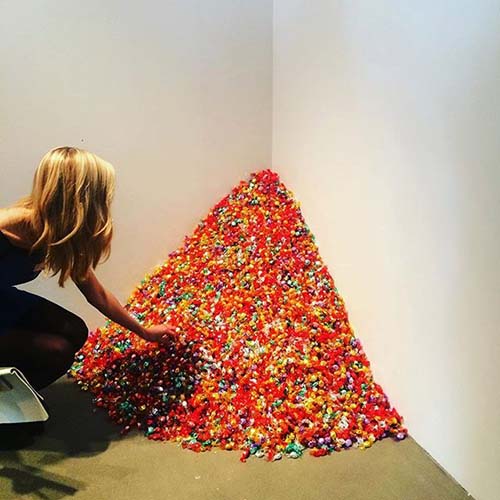
How to observe paintings – a closer look at the shape, support, medium, or materials…
ArtWizard 15.06.2020
ArtWizard presents a series of articles about the basic principles of observing paintings. This week, we present how the shape, support, and materials in paintings play a role in expressing the view of the artist that creates them.
In order to be good at observing paintings, a collector needs to understand how important are the shape, support, and materials as to the final outcome of an artwork. Artists paint on all types of surfaces (supports) and in the different art movements and different times, there have been various supports that artists used the most. There are or course some standard forms that have remained no matter what was the timing or art movement – the portraits that are in most cases vertical, the landscapes and nature-mortes that are in most cases in a landscape surface and sometimes on circle or oval. The shape in the paintings has been determined almost always by the subject matter chosen by the artist. Supports have been frequently wood, linen, or canvas, which defines in some cases also the outcome of what the artist wanted to achieve.
Some of the artists experimented with shapes and forms, as well as canvases and support surfaces. For example, miniatures were worn around the neck of the women or on hatbands as badges of loyalty and signs of devotion in the 16th century. The painter Nicholas Hilliard mastered the trade of a jeweler, using real gold and silver materials for decoration of his miniature portraits. In his Portrait of a Young Man using a velum laid on card, the lace collar of the portrait is painted thickly, and this type of art was known as “limning”.

Nicholas Hilliard, Portrait of a Young Man, 1588
Another interesting experiment we can observe if we look at the painting Vanitas, by Cornelius Gysbrechts, although as support and materials he used the standard oil on canvas. However, the artist is known as a “master of the trompe l’oeil” and in this painting he just had made himself some fun. The artwork is in the shape of a portrait, with the subject-matter being a very dark nature-morte, nevertheless, it looks like it has been painted on the wrong side of the canvas and revealing the back frame containing even some stains for a realistic perception that the artist wanted to show. The play with the forms and shapes in this painting is part of its uniqueness and charm. On the left side we can even see another small painting, this time in oval form although it is as a portrait. The different shapes have been used by artists for various purposes.
,_1664.jpg)
Cornelis Norbertus Gysbrechts, Vanitas (Nature morte - trompe-l'œil), 1664
However, as sometimes even large landscapes have been painted using an upright oval form in order to illustrate different parts of the story that has been told in it. This is the case with the painting The Miracle of the Holy House of Loretto by Giovanni Battista Tiepolo. The painting is again using the standard support and materials - oil on canvas, however, what is interesting about it is that this painting was in fact a study for a fresco for the Venice Church Scalzi, that no longer can be seen. The oval form is cleverly used to tell the story of the “earthly sinners” that stand at the bottom of the oval and goes upwards to show the saints and angels standing above the earth and its inhabitants to go to its highest part (the top of the oval), showing the images of God and the Holy Ghost.

Giovanni Battista Tiepolo, The Miracle of the Holy House of Loretto, 1743
What can be observed even from old times is that different supports and shapes are used to tell specific stories. It is interesting to see that things have not much changed in contemporary art. We see examples of how the shapes, the supports and the materials are speaking for themselves a great part of the language of the artworks. This is very true for example for the work Morning Choice by Anne Truitt, where the support and material are all the artwork has to say about itself, made of acrylic on marine plywood. The colors and shapes of this work are the very essences of what the artist wanted to express with it, hovering between painting and sculpture with bright and provocative colors, speaking about itself by its shape and materials only.

Anne Truitt, Morning Choice, 1968
The importance of the shape and material is also used to speak for itself in conceptual art. One of the best examples of that is the work of Lucio Fontana named Spatial Concept, based on slashed canvas and gauze. Attacking the illusion of painting, the aggressive slit is literary cutting the material, revealing the texture of linen canvas to the spectator. Another very famous example as to how the material adds to the concept of artwork is The Candies of Felix Gonzalez-Torres. At one of the first exhibitions of his conceptual work, the spectators are invited to take candies from the pile exhibited, in order to see how the body of the soulmate of Felix was disappearing as a result of his terminal illness. That is one of the most powerful conceptual artworks using special materials to speak about itself – in the case of Felix Gonzales-Torres – these are the candies that he used as shape support for his conceptual work.
,_1991.jpg)
Felix Gonzalez-Torres, Untitled (Portrait of Ross in L.A.), 1991

Lucio Fontana, Spatial Concept, 1960
In our next article we will see how the mediums play a role on art.
